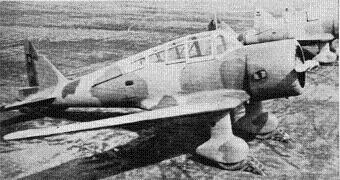![]() The Pacific War Online Encyclopedia
The Pacific War Online Encyclopedia
|
| Previous: Ki-34 "Thora", Japanese Transport Aircraft | Table of Contents | Next: Ki-43 "Oscar", Japanese Fighter |

U.S. Air Force. Via Francillon (1979)
Tachikawa
Ki-36 "Ida"
| Crew | 2 |
| Dimensions | 38'9" by 26'3" by 11'11" 11.8m by 8m by 3.64m |
| Wing area | 215
square feet 20 square meters |
| Weight | 2749-3660 lbs 1247-1660 kg |
| Maximum speed | 216 mph at 5905 feet 348 km/h at 1800 meters |
| Cruising speed | 147 mph 237 km/h |
| Climb rate | 25 feet per second 7.6 meters per second |
| Service ceiling | 26,740 feet 8150 meters |
| Power plant | One 450 hp (336 kW) Hitachi Ha-13a 9-cylinder radial engine driving a two-blade wooden propeller. |
| Armament | One 7.7mm
Type 89 Model 2 machine gun (cowling) One 7.7mm Type 89 Special machine gun (rear cockpit) |
| External stores | 10 33lb (15 kg) bombs for conventional attack, or one 1102 lb (500 kg) bomb for suicide sorties |
| Range | 767 miles 1230 kg |
| Production | A total of 1332 production Ki-36:
Tachikawa Hikoki K.K.: 860 Ki-36 from November 1938 to January 1944 Kawasaki Kokuki Kogyo K.K.: 472 Ki-36 from June 1940 to May 1942 (Gifu plant) |
| Variants |
The Ki-55 was a trainer version. |
The Tachikawa Ki-36 was an Army
cooperation aircraft,
intended primarily for battlefield observation but with some
ground-attack
capability. It was designed to operate from small airstrips
and to be capable
of maneuvering at low speeds and altitudes.
The design went back to May 1937, when the Army
issued a specification for a fast monoplane reconnaissance
aircraft
with a good rough field capability. The design team, under Endo
Ryokichi, achieved the required low-speed maneuverability by
combining
a light airframe with large wings. The wings were swept well back
to
give the pilot good visibility, while windows under the wing
center
sections gave the observer a good field of view. Its control
surfaces were
unusually large, which made it very light on the controls. The
prototype first
flew on 20 April 1938 and the design went into production in
November
1938.
Its characteristics made the aircraft
highly vulnerable,
and it could only be effectively utilized in controlled airspace,
which
meant
that it saw most of its action in China.
A small number were given to Thailand.
Its characteristics were suitable for a trainer and the Ki-55 was a modified version produced for this purpose.
References
The Pacific War Online Encyclopedia © 2007, 2009-2010 by Kent G. Budge. Index